If you’re craving a dish that’s as satisfying as it is quick to prepare, look no further than Pad Thai. This iconic street food from Thailand combines rice noodles with a perfect blend of flavors and textures, making it a beloved choice for both casual dining and special occasions. In this recipe, you’ll find a balance of savory, sweet, and tangy elements that create an unforgettable taste experience. Not only is it delicious, but it also allows for customization depending on your preferences. Whether you’re a fan of shrimp, chicken, or tofu, you can easily adapt the ingredients to suit your taste. The vibrant colors and aromatic scents of this dish will fill your kitchen with delightful energy. So grab your wok or large skillet and let’s dive into the world of homemade Pad Thai!
Why You’ll Love This Pad Thai
- Quick and Easy: Minimal prep time and straightforward steps make this recipe stress-free, even for novice cooks
- Flavorful and Versatile: Enjoy outstanding flavor with ingredients you can easily customize by adding your favorites or adjusting spices
- Perfect for Any Occasion: Ideal for casual gatherings, holiday celebrations, or weeknight dinners
Ingredients for Pad Thai
Here’s what you’ll need to make this delicious dish:
- Rice Noodles: Use flat rice noodles typically labeled as “Pad Thai noodles” for the best texture.
- Shrimp or Chicken: Fresh shrimp or boneless chicken breast works well; choose based on your preference.
- Eggs: Eggs add richness and protein; use one or two depending on your serving size.
- Bean Sprouts: Fresh bean sprouts add crunch; look for firm sprouts without any dark spots.
- Green Onions: Chopped green onions enhance flavor; use both the white and green parts.
For the Sauce:
- Tamarind Paste: Essential for that signature tangy flavor; check the Asian section in grocery stores.
- Soy Sauce: Use low-sodium soy sauce to better control the saltiness.
- Fish Sauce: This adds depth; adjust based on personal taste preferences.
- Brown Sugar: Balances out the flavors; use light brown sugar for best results.
The full ingredients list, including measurements, is provided in the recipe card directly below.
How to Make Pad Thai
Follow these simple steps to prepare this delicious dish:
Step 1: Prepare the Noodles
Soak rice noodles in warm water according to package instructions until they are soft but not mushy. Drain them well before using.
Step 2: Make the Sauce
In a bowl, combine tamarind paste, soy sauce, fish sauce, and brown sugar. Stir until well blended and set aside.
Step 3: Cook Your Protein
In a large skillet or wok over medium-high heat, add oil. Once hot, add shrimp or chicken pieces. Cook until they turn opaque or golden brown—about three to five minutes.
Step 4: Add Vegetables and Eggs
Push cooked protein to one side of the skillet. Crack eggs into the other side and scramble them until just set. Then mix everything together along with bean sprouts and green onions.
Step 5: Combine Noodles with Sauce
Add drained rice noodles to the skillet along with prepared sauce. Toss gently until all ingredients are combined and heated through—about two minutes should suffice.
Step 6: Serve It Up
Transfer to plates and drizzle with additional lime juice if desired for the perfect finishing touch.
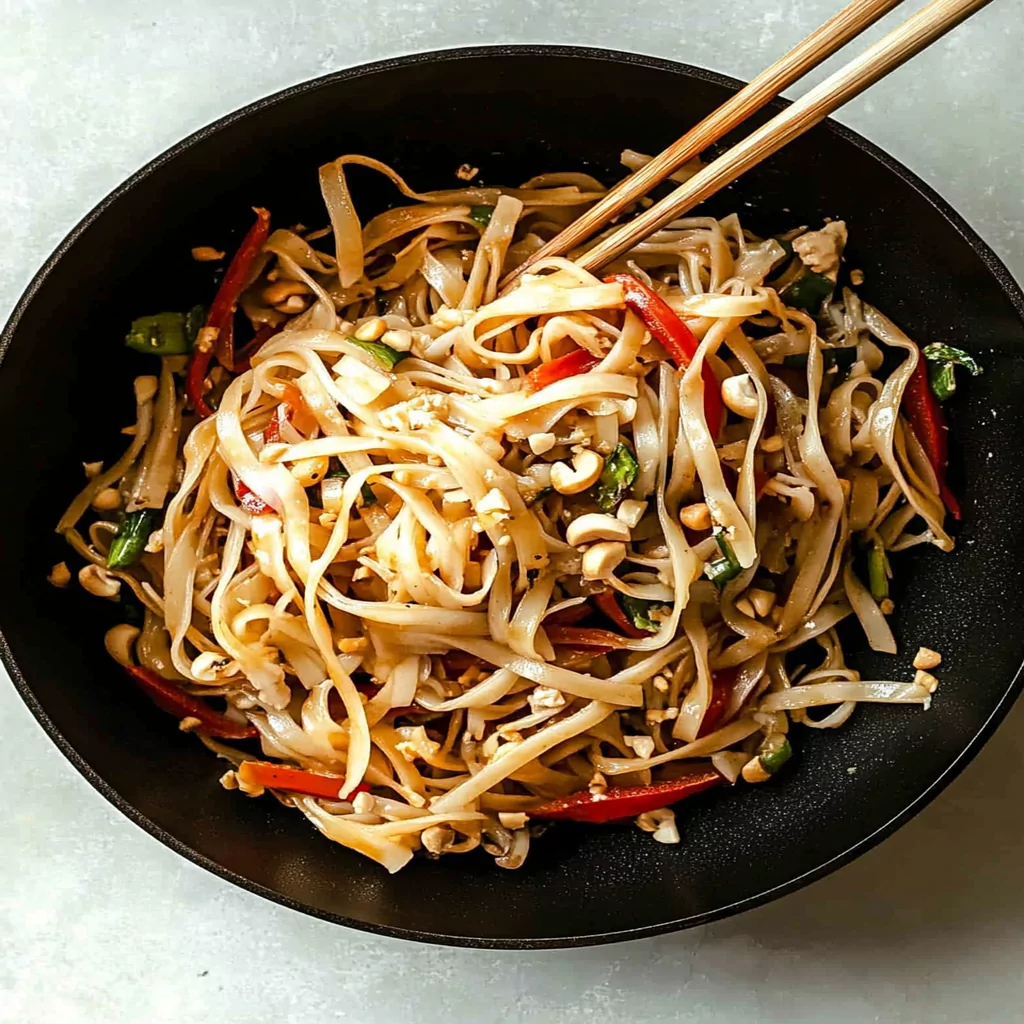
Tips and Tricks
Here are some helpful tips to ensure the best results for your dish:
- Even Cooking: Make sure all ingredients are cut to similar sizes for consistent cooking times.
- Temperature Control: Let ingredients reach room temperature before starting for better results.
- Advanced Technique: For enhanced flavor, try marinating shrimp or chicken in soy sauce before cooking.
How to Serve Pad Thai
This Pad Thai is versatile and pairs wonderfully with:
- Rice or Potatoes: A hearty base that soaks up the delicious sauce.
- Fresh Salad: Adds a crisp and refreshing contrast to the rich flavors of the dish.
- Crusty Bread: Perfect for enjoying every last drop of the flavorful sauce.
Feel free to pair it with your favorite sides for a personalized meal!
Make Ahead and Storage
- Make Ahead: You can prepare components like the sauce and vegetables in advance. Store them in airtight containers in the refrigerator for up to three days. Cooked noodles can also be made ahead of time; just rinse them in cold water after cooking to prevent sticking.
- Storing: Leftover Pad Thai can be stored in an airtight container in the fridge for up to four days. For longer storage, consider freezing it in a freezer-safe container where it can last up to three months.
- Reheating: To reheat, place leftover Pad Thai in a skillet over medium heat. Add a splash of water or oil and stir frequently for about five to seven minutes until heated through, ensuring not to overcook it.
FAQs for Pad Thai:
What is Pad Thai?
Pad Thai is a traditional Thai stir-fried noodle dish that has gained immense popularity worldwide. Typically made with rice noodles, it features a combination of ingredients such as shrimp, chicken, or tofu, along with bean sprouts, peanuts, and egg. The dish is flavored with tamarind paste, fish sauce, and lime juice, giving it a unique sweet and sour taste. Often garnished with fresh herbs and lime wedges, Pad Thai provides a delightful balance of textures and flavors that appeals to many palates. Its cultural significance in Thailand makes it not just a meal but also an experience that connects you to the vibrant culinary heritage of the region.
How do I make Pad Thai at home?
Making Pad Thai at home is easier than you might think. Start by soaking rice noodles in warm water until they soften. In a hot pan or wok, add oil and stir-fry your choice of protein—like shrimp or chicken—until cooked through. Push the protein to one side and add beaten eggs to scramble them. Next, incorporate the softened noodles along with tamarind paste, fish sauce, sugar, and chili flakes for flavor. Mix everything well until heated through. Finally, add fresh bean sprouts and chopped green onions for crunch before serving it hot. With a squeeze of lime juice on top, your homemade Pad Thai will be ready to enjoy!
Can I customize my Pad Thai recipe?
Absolutely! One of the best features of Pad Thai is its versatility. You can easily customize it based on dietary preferences or ingredient availability. For instance, if you’re vegetarian or vegan, substitute meat with tofu or tempeh and use soy sauce instead of fish sauce for flavoring. You can also experiment with different vegetables like bell peppers or broccoli to enhance nutritional value. Adding extra toppings like crushed peanuts or cilantro can elevate the dish further. Feel free to adjust the spices according to your taste; this adaptability makes Pad Thai a favorite among many food enthusiasts.
What toppings are best for Pad Thai?
Toppings play a crucial role in enhancing the overall experience of eating Pad Thai. Commonly used toppings include crushed peanuts, which add crunch and richness; fresh lime wedges for acidity; and bean sprouts for texture. Additionally, chopped green onions and cilantro can provide freshness and color. Some people enjoy adding chili flakes or sliced red chilies for heat; this balances well with the sweetness of the tamarind sauce. Experimenting with various toppings allows you to create a personalized dish that reflects your taste while staying true to the essence of traditional Pad Thai.
Is Pad Thai healthy?
Pad Thai can be part of a healthy diet when made mindfully. It typically contains protein from shrimp or chicken and fiber from vegetables like bean sprouts and green onions. However, it’s essential to watch portion sizes due to its calorie-dense ingredients such as oil and peanuts. To make it healthier at home, consider using less oil during cooking or incorporating more vegetables into the mix. Opting for whole grain rice noodles instead of regular ones can also boost fiber content while reducing refined carbohydrates in your meal.
Can I prepare Pad Thai in advance?
Yes! Preparing Pad Thai in advance is possible but requires some careful planning due to the nature of its ingredients. You can cook your proteins and vegetables ahead of time; just store them separately from the noodles and sauces until you’re ready to serve. When you’re set to eat, briefly reheat everything in a pan before mixing in the noodles along with your sauces for flavoring. While freshly made Pad Thai tastes best right after cooking due to its unique textures, preparing components ahead saves time without sacrificing too much quality.
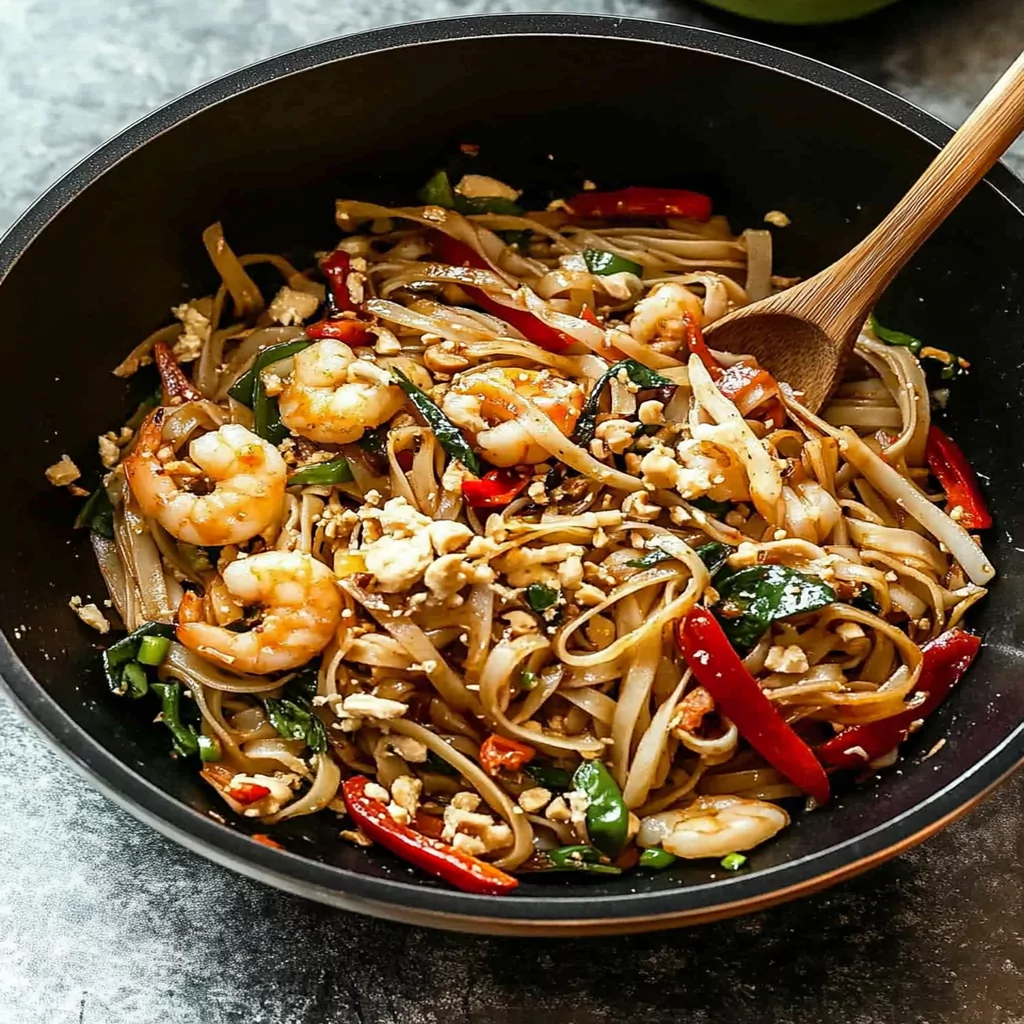
Conclusion for Pad Thai:
In summary, Pad Thai is a beloved dish known for its delicious combination of flavors and textures that captures the essence of Thailand’s culinary traditions. Making it at home allows you to customize ingredients according to personal preferences while maintaining its authentic appeal. Whether you enjoy it as a quick weeknight dinner or as part of an elaborate spread for guests, this dish never fails to impress. By exploring various toppings and adjustments based on dietary needs or restrictions, you can create a unique version that suits your taste buds perfectly while enjoying all that this classic recipe has to offer!
Print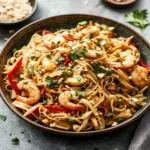
Pad Thai
- Prep Time: 15 minutes
- Cook Time: 10 minutes
- Total Time: 25 minutes
- Yield: Serves 4
Description
Pad Thai is a delightful and vibrant dish that captures the essence of Thai street food in your kitchen. This easy-to-make stir-fried noodle recipe features a harmonious blend of savory, sweet, and tangy flavors, making it a favorite for any meal. With customizable ingredients like shrimp, chicken, or tofu, you can tailor it to suit your tastes. The addition of fresh vegetables like bean sprouts and green onions brings a refreshing crunch, while the signature tamarind sauce ties everything together. Perfect for weeknight dinners or entertaining guests, this authentic Pad Thai will transport you straight to Thailand with every bite!
Ingredients
- Rice noodles (Pad Thai noodles)
- Shrimp or chicken
- Eggs
- – Bean sprouts
- Green onions
- Tamarind paste
- Soy sauce
- Fish sauce
- Brown sugar
Instructions
1. Soak the rice noodles in warm water until softened; drain.
2. Combine tamarind paste, soy sauce, fish sauce, and brown sugar in a bowl for the sauce.
3. In a hot skillet or wok with oil, cook shrimp or chicken until done; set aside.
4. Scramble eggs in the skillet, then mix in cooked protein, bean sprouts, and green onions.
5. Add drained noodles and sauce; toss to combine and heat through.
6. Serve with lime juice for an extra zing.
Notes
– Customize your Pad Thai by adding your favorite veggies like bell peppers or broccoli.
– For a vegetarian option, use tofu instead of meat.
Nutrition
- Calories: 450
- Fat: 15g
- Carbohydrates: 60g
- Protein: 25g

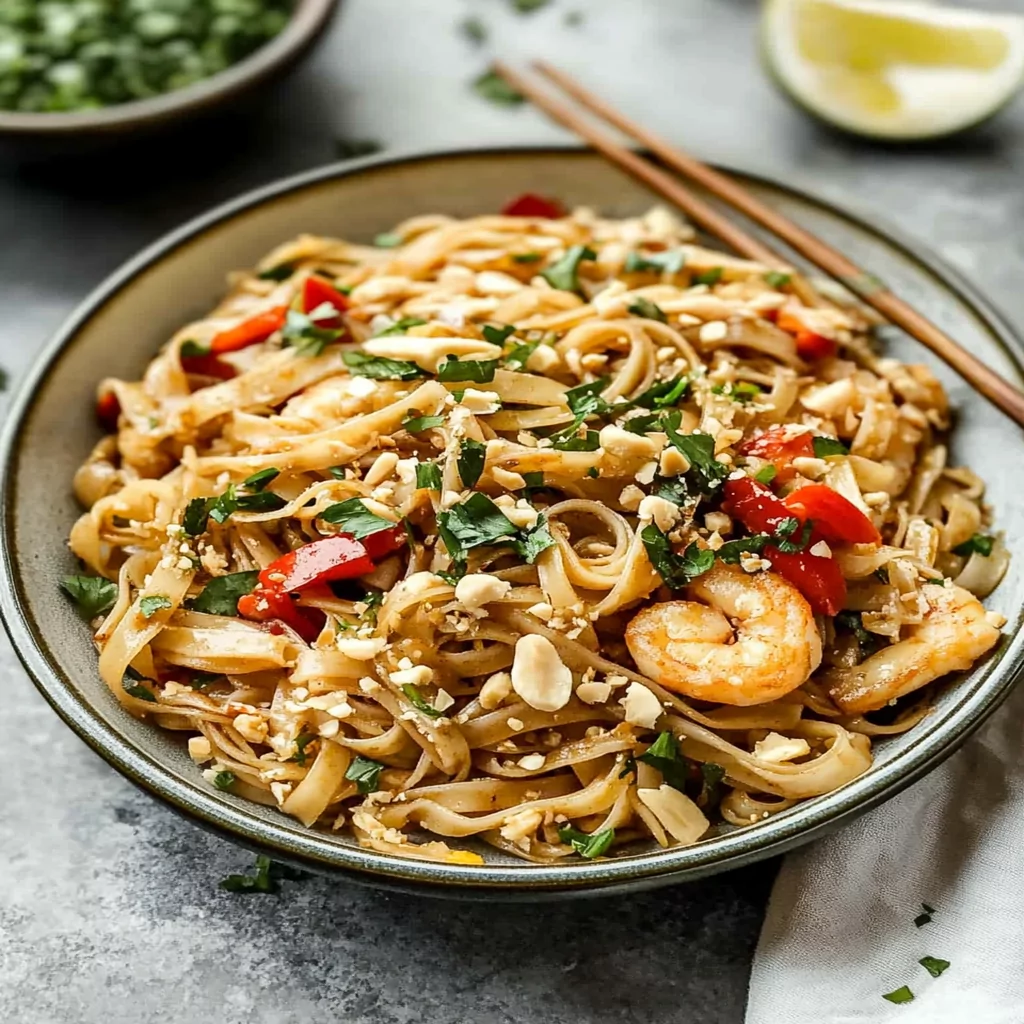


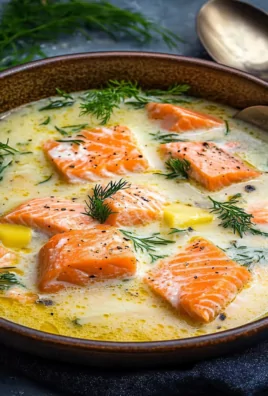
Leave a Comment